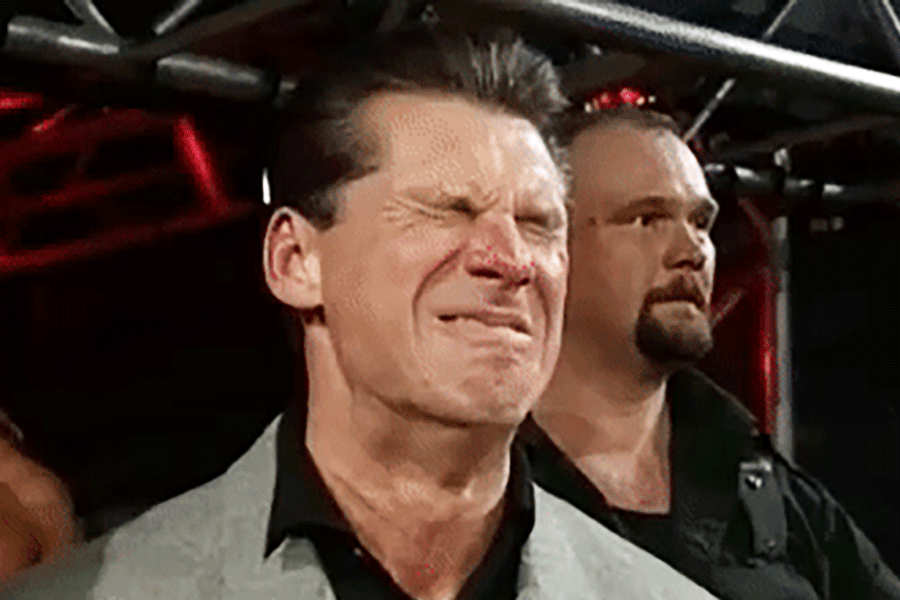The WWE I remember was actually the WWF, or World Wrestling Federation: a curious choice of name, seeing as it wasn’t a group of states but a company—one whose chairman, CEO and majority owner inserted himself into its soap-opera pseudo-reality.

This was in the late-1990s, and all my male middle-school classmates could talk about, besides GoldenEye for Nintendo 64, were the ridiculous throwdowns of Monday Night Raw, a weekly event where “Stone Cold” Steve Austin delivered “Stone Cold Stunners” and The Rock (soon to become actor Dwayne Johnson) would raise the People’s Eyebrow to ask if we smelled what he was cooking. The wrestling felt goofy even then; I watched for the plot, the ringside betrayals and backstage threats, and nobody was better at driving those tawdry adult situations than the man who made the executive decision to elevate them in this so-called “Attitude Era”: Vince McMahon, known to me then as Mr. McMahon.

No matter how many times McMahon tries to restart the XFL, a failed professional football league, or how much he sucks up to Donald Trump (WWE donated $4 million to Trump’s supposed charity in 2007, and McMahon’s wife Linda now runs the president’s Small Business Administration), it’s his performance as a ruthless heel in the ring that he’ll be remembered for.
The gimmick was perfect: Outed as the corporate puppetmaster of the wrestling empire, he used his position to heckle, bully, harass, torture and humiliate the working-class warriors who owed their fame (and jobs) to him, typically while disparaging the audience as a collection of redneck assholes. He was the boss from hell, and the anti-capitalist satire wasn’t lost on a kid: Nothing was finer than seeing a disgruntled employee deliver McMahon’s brutal, well-earned comeuppance.

With that power dynamic in place, McMahon found his true calling, not as a wrestler but a comedian. His rubber-faced reactions to every twist of allegiance or control, ranging from awe to disgust to evil glee, matched the scale and sentiment of a packed arena baying for blood. Against him, everyone else had to play the straight man, regarding the sport as a serious if not sacred spectacle. McMahon alone had the privilege of treating the whole thing like a joke told for his own amusement — which, in a sense, it was. Then and now, it seems impossible to think of anybody who had more fun around the office.
And that’s why, in the internet age that followed, he was reincarnated as pure GIF.

The GIF, or graphics interchange format, has existed since the 1980s, when McMahon was still commentating on matches instead of brawling in them. An early update allowed for animation support, and Web 1.0 sites featured such moving images as embellishments and silly diversions. (The very first showed a pixelated plane in flight.) Rather quickly, these conquered the internet, and pages clogged with them were seen as tacky nightmares of design. The rise of meme culture and social media, combined with the availability of apps for easily generating GIFs, meant a renaissance for the medium, which now ranks among the dominant forms of visual communication. As they often serve to convey some reactive emotion, McMahon’s kayfabe hamminess has turned him into the human equivalent of the format, unmistakable in his mood or affect.

Search “Vince McMahon GIF” and you’ll be entertained for days, scrolling through grid upon grid of scowls, leers, grins and silent screams — far more than you’ll find from fellow GIF legends like Nic Cage or Tiffany Pollard. Somehow, there’s one for every occasion, though amazingly, there’s also a clear favorite: In 2002, WWE aired a segment in which wrestler and model Stacy Keibler “interviewed” for a job as McMahon’s personal assistant by dancing seductively on his desk. From the moment she enters the stadium, McMahon is visibly dazzled, and he ratchets up his horndog euphoria, bit by bit, until a climactic bliss literally knocks him backward out of his chair.
Apart from clips of McMahon’s intoxicated “power walk,” this joyful crescendo is the most remixed of his moments, with virtually any source of pleasure edited in where Keibler originally flaunted her stuff. A bodybuilder, the lineup of Marvel’s forthcoming films, snippets from the U.K. Labour Party’s leaked manifesto, Game of Thrones, basketball highlights, Ronda Rousey’s punches, or the making of a ham-and-bacon sandwich: You name it, McMahon has gone into raptures for it. Check out Reddit’s r/VinceMcmahongifs and you’ll even find him wowed by his own breakdancing.
Will one man’s face ever mean so much again? Doubtful. And probably no one, here at the height of GIFdom, could feasibly hope to topple McMahon as king of loony loops. His countless scandals and sleazy dealings in real life are in no way absolved by this contribution to the culture, but we must recognize it just the same, for it allows us a streamlined read of the American id, with zero ambiguities: a lust for cash and authority combined with a seething hatred for anyone else who would dare to seek higher status. In order for McMahon to win, the rest of us must lose, and the weirdest part is that’s what the fans want: to be unthinking, violent rabble.
Sounds familiar, doesn’t it?


